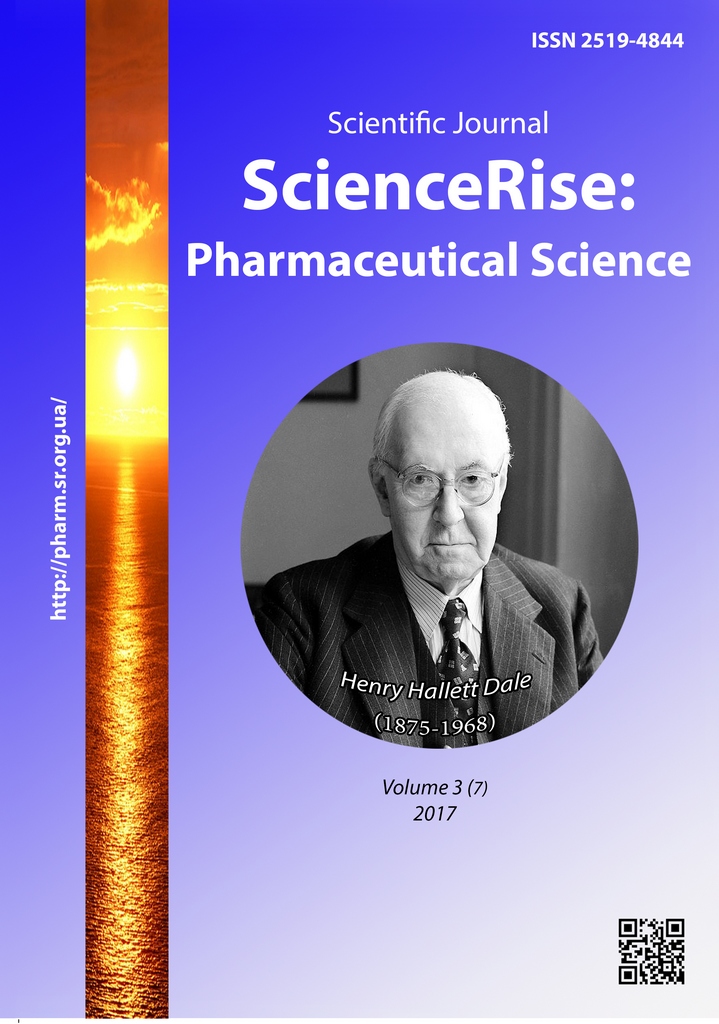The study of PS biocomplex as a promising antimicrobial preservative in compositions of medicinal and cosmetic products
DOI:
https://doi.org/10.15587/2519-4852.2017.103442Keywords:
surfactants, PS biocomplex, antimicrobial preservatives, emulsions, remedies, cosmetic productsAbstract
Aim. Research of efficiency of PS biocomplex as an antimicrobial preservative in composition of medicinal and cosmetic products, as well as determination of its active concentration as a preservative in emulsion systems of various types.
Methods. Methods of information search, literature data analysis, microbiological and technological methods were used.
Results. To study preserving ability of PS biocomplex and to compare its activity with the known preservatives, emulsion-type bases o/w and w/o were used. Ten emulsions of each type with different concentration of PS biocomplex were developed, as well as its consistent use with parabens, sodium benzoate, benzalkonium chloride and silver nanoparticles.
PS biocomplex in studied concentrations ranging from 0.025 % to 0.1 % shows effectiveness as a preservative. However, in concentrations of 0.025 and 0.05 % it can be used as a preservative only in w/o emulsions type with low content of aqueous phase. The use of PS biocomplex in concentration of 0.1 % meets pharmacopoeial criteria to the effectiveness of antimicrobial preservatives for emulsions of both types.
The simultaneous use of PS biocomplex with other preservatives can reduce the concentration of the latter in of emulsion products composition, due to increase of preserving activity of the studied emulsions.
Conclusion. Results of research of PS biocomplex preserving activity show prospects of its further study as an antimicrobial preservative aiming to implement in of medicinal and cosmetic products manufacture, that will help to expand the range of excipients for skin application products
References
- Walters, Y., Roberts, M. (Eds.) (2008). Dermatologic, cosmeceutic and cosmetic development. Boca Raton: CRC Press, 644. doi: 10.3109/9780849375903
- Kalinyuk, T. H., Bokshan, E. V., Bilous, S. B. et. al. (2008). Praktykum z tekhnolohiyi likarsʹkych kosmetychnych zasobiv [Workbook of technology of cosmetic products]. Kyiv: Medicine, 184.
- Voronov, S. A., Stetsyshyn, U. B., Pavchenko, U. V., Vasiliev, V. P.; Voronov, S. A. (Ed.) (2010). Toksykolohichna khimiya kharchovykh produktiv ta kosmetychnykh zasobiv [Toxicological chemistry of food and cosmetics]. Lviv: Publisher Lviv Polytechnic, 316.
- Banat, I. M., Franzetti, A., Gandolfi, I., Bestetti, G., Martinotti, M. G., Fracchia, L. et. al. (2010). Microbial biosurfactants production, applications and future potential. Applied Microbiology and Biotechnology, 87 (2), 427–444. doi: 10.1007/s00253-010-2589-0
- Singh, P., Cameotra, S. S. (2004). Potential applications of microbial surfactants in biomedical sciences. Trends in Biotechnology, 22 (3), 142–146. doi: 10.1016/j.tibtech.2004.01.010
- Rodrigues, L. (2006). Biosurfactants: potential applications in medicine. Journal of Antimicrobial Chemotherapy, 57 (4), 609–618. doi: 10.1093/jac/dkl024
- Abalos, A., Pinazo, A., Infante, M. R., Casals, M., Garcia, F., Manresa, A. (2001). Physicochemical and antimicrobial properties of new rhamnolipid produced by Pseudomonas aeruginosa AT10 from soybean oil refinery wastes. Langmuir, 17 (5), 1367–1371. doi: 10.1021/la0011735
- Chueshov, V. I., Hladuh, E. V., Sayko, I. V. et. al. (2013). Tekhnolohiya likiv promyslovoho vyrobnytstva [Industrial technology of drugs]. Kharkiv: NFaU: Oryginal, 638.
- Nastanova 42-3.1:2004. Nastanovy z jakosti. Likars'ki zasoby. Farmacevtichna rozrobka (2004). Kyiv: MOZ Ukrainy, 15.
- Regulation (EC) No 1223/2009 of the European Parliament and of the Council of 30 November 2009 on cosmetic products (2009). Official Journal of the European Union. Available at: http://eur-lex.europa.eu/LexUriServ/LexUriServ.do?uri=OJ:L:2009:342:0059:0209:en:PDF
- Derzhavna Farmakopeya Ukrainy. Vol. 1. Vol. 2. Vol. 3 (2014). Kharkіv: Derzhavne pіdpryiemstvo «Ukrains'kyj naukovyi farmakopejnyj centr yakostі lіkars'kyh zasobіv», 1130, 724, 732.
- Sim, L., Ward, O. P., Li, Z.-Y. (1997). Production and characterisation of a biosurfactant isolated from Pseudomonas aeruginosa UW-1. Journal of Industrial Microbiology and Biotechnology, 19 (4), 232–238. doi: 10.1038/sj.jim.2900450
- Kremy cosmetychni: DSTU 4765:2007 (National standart of Ukraine) (2008). Kyiv: Derzhspozhyvstandart Ukrainy, 7.
Downloads
Published
How to Cite
Issue
Section
License
Copyright (c) 2017 Iryna Pelekh, Nadia Dilai, Svitlana Bilous, Rosa Vildanova, Oleksandr Shulha

This work is licensed under a Creative Commons Attribution 4.0 International License.
Our journal abides by the Creative Commons CC BY copyright rights and permissions for open access journals.








